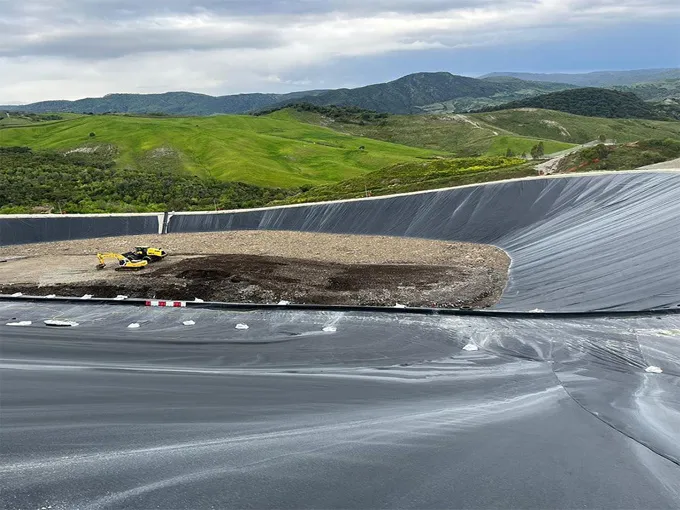Introduction: Understanding Geomembrane Basics
Geomembranes play a critical role in modern containment systems, serving as impermeable barriers in applications ranging from waste management to water conservation. Among the various polymer options available, HDPE (High-Density Polyethylene) and LLDPE (Linear Low-Density Polyethylene) stand out as two of the most widely used materials. While they share a common polyethylene heritage, their molecular structures create distinct performance characteristics that make each better suited for specific applications.This in-depth guide provides a detailed technical comparison between HDPE and LLDPE geomembranes, examining their material properties, installation requirements, cost considerations, and ideal use cases. Whether you're an engineer specifying materials for a large-scale landfill project or a farmer looking to line an irrigation pond, understanding these differences will help you make the most informed decision for your containment needs.

Material Properties: A Molecular-Level Comparison
Density and Molecular Structure
The fundamental difference between these materials lies in their polymer chain structure:
HDPE: Features minimal branching in its molecular chains, resulting in:
Higher density (0.941-0.965 g/cm³)
Greater crystallinity
Superior tensile strength
Reduced flexibility
LLDPE: Contains controlled branching through its production process, leading to:
Lower density (0.915-0.930 g/cm³)
More amorphous regions
Enhanced flexibility
Improved stress crack resistance
Mechanical Performance Comparison
(40 mil thickness standard comparison)
| Property | HDPE Geomembrane | LLDPE Geomembrane |
|---|---|---|
| Tensile Strength | 84 psi (15 kN/m) | 152 psi (26.6 N/mm) |
| Elongation at Break | 18% | 800% |
| Tear Resistance | 28 lbs (125 N) | 22 lbs (98 N) |
| Puncture Resistance | 72 lbs (320 N) | 61 lbs (271 N) |
| Low-Temp Performance | Brittle below -20°C | Flexible to -56°C |
Installation Considerations: Practical Implications
Field Deployment Challenges
HDPE Installation:
Requires precise subgrade preparation (removal of sharp protrusions)
Needs experienced welding crews (higher fusion temperatures: 300-350°C)
Limited foldability increases transportation costs
More susceptible to stress cracking if improperly handled
LLDPE Installation:
Tolerates minor subgrade imperfections better
Lower welding temperatures (250-300°C) reduce energy costs
Can be pre-fabricated in panels and folded for transport
Better conforms to irregular geometries (e.g., rock protrusions)
Welding Techniques Comparison
Both materials use thermal fusion welding, but with key differences:
| Parameter | HDPE Welding | LLDPE Welding |
|---|---|---|
| Optimal Temperature | 320-350°C | 280-320°C |
| Cooling Time | Longer (15-20 min) | Shorter (10-15 min) |
| Seam Strength | 90% of parent material | 85% of parent material |
| Equipment Cost | Higher | Moderate |
Performance in Extreme Conditions
Chemical Resistance
Both materials resist most acids, alkalis, and salts, but differ in:
Hydrocarbon Resistance:
HDPE performs better with non-polar solvents (e.g., oils, fuels)
LLDPE shows superior resistance to polar compounds (e.g., alcohols)
Oxidation Resistance:
HDPE's higher crystallinity provides better UV stability
Both contain 2-3% carbon black for UV protection
Temperature Extremes
High-Temperature Performance:
HDPE maintains integrity up to 80°C (176°F)
LLDPE softens above 70°C (158°F)
Low-Temperature Behavior:
HDPE becomes brittle below -20°C (-4°F)
LLDPE remains flexible to -56°C (-69°F)
Lifecycle Cost Analysis
Initial Costs
Material Costs:
HDPE: 0.65−0.65−1.20/sq.ft (1.5mm thickness)
LLDPE: 0.55−0.55−1.00/sq.ft (1.5mm thickness)
Installation Costs:
HDPE typically 15-25% higher due to:
More stringent subgrade requirements
Higher skilled labor needs
Increased welding time
Long-Term Value
Service Life:
HDPE: 30-50 years in properly designed systems
LLDPE: 20-30 years under similar conditions
Maintenance Considerations:
HDPE's stress crack resistance reduces long-term repairs
LLDPE's flexibility minimizes puncture damage over time
Industry-Specific Recommendations
Best Uses for HDPE
Municipal Solid Waste Landfills
Primary and secondary liner systems
Final cover systems
Mining Applications
Heap leach pads
Tailings impoundments
Industrial Containment
Secondary containment for chemical storage
Brine ponds
Optimal LLDPE Applications
Agricultural Water Management
Irrigation ponds
Aquaculture liners
Decorative Water Features
Landscape ponds
Golf course water hazards
Temporary Containment
Construction dewatering ponds
Emergency spill containment
Emerging Trends and Innovations
Material Advancements
Coextruded Geomembranes: Combining HDPE/LLDPE layers for balanced properties
Antimicrobial Additives: For aquaculture and wastewater applications
Enhanced UV Stabilizers: Extending service life in exposed applications
Installation Technologies
Robotic Welding Systems: Improving seam quality consistency
GPS-Enabled Deployment: Optimizing panel layout and material usage
Real-Time Leak Detection: Integrated sensor systems during installation
Decision-Making Framework
When selecting between HDPE and LLDPE, consider this four-factor evaluation:
Project Duration:
Long-term (>25 years): HDPE
Short/medium-term: LLDPE
Environmental Stresses:
Chemical exposure: HDPE
Temperature extremes: LLDPE for cold, HDPE for heat
Site Conditions:
Flat, stable surfaces: HDPE
Irregular terrain: LLDPE
Budget Constraints:
Higher upfront budget: HDPE
Cost-sensitive projects: LLDPE
Conclusion: Making the Right Choice
The HDPE vs. LLDPE decision ultimately depends on your specific project requirements. While HDPE offers superior long-term durability and chemical resistance for critical containment applications, LLDPE provides exceptional flexibility and cost-efficiency for less demanding environments.
For projects where both strength and flexibility are needed, consider:
Multilayer composite systems
Site-specific material zoning
Hybrid installation techniques
Always consult with geosynthetic specialists to conduct:
Site-specific testing
Accelerated aging studies
Cost-benefit analyses
By carefully weighing these technical factors against your project's unique needs, you can implement a geomembrane solution that delivers optimal performance, value, and longevity.


